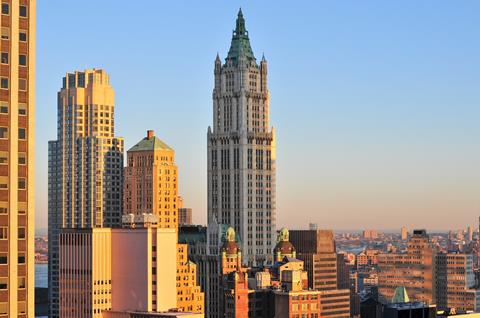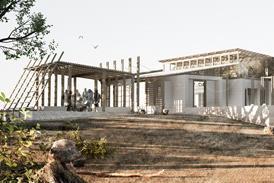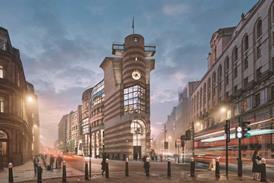Chris Fogarty explains how high vacancy rates, financial pressures and new tax incentives are finally tipping the balance towards conversion

Three years ago, my firm finished construction on our first office building in downtown Brooklyn. It has won numerous awards, is in a great location and has amazing views. The project began pre-Covid, when the Brooklyn office market was going to be the next big thing. Sadly, it has sat empty since completion, and it’s not alone.
Since the pandemic, endless discussions and articles have explored how to turn New York’s vacant offices into much-needed housing. Even as companies try to bully or entice their staff back into the office, some form of remote work has become routine for many, and the office market has struggled to get back to full occupancy.
Five years since Covid hit NYC, you would have expected one of two things to have happened: either a collapse in office rents or a flood of conversions. In reality, neither has occurred. Only now are we beginning to see signs of a real change in the market.
At our own firm, we’ve stayed busy, grown our practice and even considered expanding, especially if it meant getting more space for less rent. But that opportunity never materialised.
Why? Because commercial real estate financing creates a “catch 22” for office owners: lowering office rents triggers a mark-to-market revaluation of the building, often to a level below the outstanding mortgage. As a result, landlords are incentivised to hang onto zombie buildings, half-empty and overleveraged, while they service what debt they can and desperately hope for demand to rebound.
In New York, many prewar office buildings have already been converted to residential use
Class B and C buildings, often outdated and tired, have mainly borne the brunt of this crisis. Having kicked the can down the road for nearly five years, banks are now finally having to repossess properties, take their losses and offload them to a new crop of developers and investors.
With office vacancies hovering near a record high of 20%, while rental apartments are at a record low of 1%, the economics of converting are finally beginning to make sense.
In New York, many prewar office buildings have already been converted to residential use. These older structures, often architecturally beautiful, were built before the advent of air conditioning. They typically feature shallow floor plates, ample windows and high ceilings, making them easy and appealing to convert.

We’ve been fortunate enough to work on several, including 15 Park Row, a wonderful early historic skyscraper downtown near the Woolworth Building (also now partially converted). What remains are the late 20th-century glass and steel boxes with deep floor plates, sealed facades and little architectural charm.
These glass and steel buildings of the post-WWII building boom were designed for open-plan offices, not living rooms and bedrooms. The layouts they produce – long, narrow units often with interior “home offices” or windowless bedrooms – are not great.
While they may work for transient younger renters who just need a place to sleep, they’re much less desirable for families. Their old monotonous curtain wall facades usually need some retrofitting to meet current residential ventilation codes, but there’s little opportunity or budget to improve their visual appearance.
There’s also the question of their location. Many of these buildings are in business districts that were built for commuters, not residents. Transit? Excellent. Grocery stores, schools, parks? Often less so.
Finally, one of the major obstacles to office-to-residential conversions is that these buildings are rarely delivered fully vacant. Landlords intentionally stagger lease terms to maintain a steady income and to avoid complete vacancy.
However, for a successful conversion, an empty building is ideal. It allows for faster timelines, fewer construction complications and more efficient system upgrades.
Despite all these challenges, there’s real potential. From an environmental standpoint, conversions are a major win.
Saving embodied carbon, swapping out outdated mechanical systems and installing high-performance windows can dramatically cut operational emissions. A recent study by Arup of over 200 potentially convertible buildings in NYC found that their operational carbon emissions could fall by 50% by 2030.
What was once a slowly dying neighbourhood now houses over 66,000 residents
Compared to new construction, embodied carbon emissions would also be about 50% lower. If all 200 buildings were converted, they could deliver nearly 150 million sq ft of housing and save almost 11 million metric tons of CO₂ by 2050.
NYC has been here before. After the early ’90s recession, Wall Street and the Financial District were plagued by high office vacancy rates. The city responded with tax incentives, zoning tweaks and infrastructure investments.
Over time, FiDi transformed. What was once a slowly dying neighbourhood now houses over 66,000 residents – up from just 13,000 in 1990. Supermarkets and grocery stores have opened, and new coffee shops and cafes are filling the once vacant storefronts again. It has become a thriving community.
Today, the city and state are once again stepping in. A new “467-m” tax abatement offers developers 90% property tax relief for as long as 35 years on conversion projects.
The city also updated its zoning to make it easier to convert newer buildings across Manhattan and some parts of Brooklyn. To qualify, at least 25% of units must be permanently affordable, with at least 5% of these units being for households that earn 40% or less of the area median income (AMI).
As a result, the conversion market is heating up. We’re studying multiple projects each week and, in some cases, returning to buildings we worked on before the pandemic – places where we had previously added amenities or upgraded lobbies.
That empty building we just finished in Brooklyn? We’re now converting it into apartments.
The conversions won’t solve the housing crisis alone. The city estimates they could produce around 20,000 new homes over the next decade, a small dent in the 500,000 that planners say are needed. But it’s a start.
And right now, in a city that desperately needs more housing and a second life for its ageing office stock, it’s a step in the right direction.
Postscript
Chris Fogarty is co-founding principal of Fogarty Finger.
















No comments yet